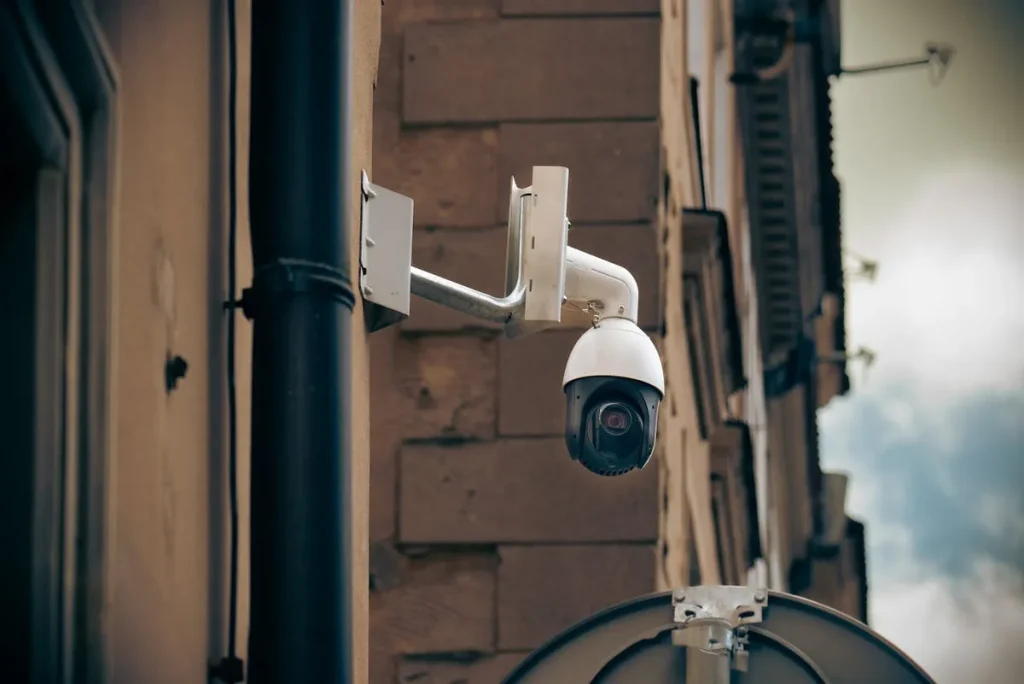
A well-designed security camera network serves as a stronghold for your business, capably monitoring guards and safeguarding assets. To establish a pertinent watchful eye framework, commence by pinpointing high-risk locations that necessitate monitoring. Following this, the selection of the most befitting cameras tailored to your unique requirements deploys. Clearly, the well-placed cameras guarantee thorough coverage free from blind zones. Post installation, a robust linking of the cameras to a potent recording system takes precedence. To wrap it up, it is vital to customize the security settings whilst regularly executing checks alongside maintenance for preserving optimum operation and fortifying your business watchful eye network security.
Identify Areas That Require Monitoring
Establishing a security camera network at your enterprise mostly depends on knowing what calls for monitoring. Direct your focus towards zones holding significant importance like entry and exit points, storage areas, or places packed with clientele. Cameras placed near doors track who strolls in and out whilst monitoring rooms filled with stock to prevent pilferage or misplacement.
Guardian spaces bustling with human activity using CCTV audibly assist in spotting any irregular behavior. Don’t overlook outdoor areas where cameras can detect prowlers before they approach your establishment. Imagine how each region under surveillance escalates the security level and work activity visibility. This meticulous examination empowers you to position only necessary security cameras.
Choose The Right Cameras
Your decision of surveillance cameras holds paramount significance for a comprehensive security cover. Should your focus be on outdoor monitoring, opting for weatherproof cameras endowed with night vision capabilities to guarantee round-the-clock sight even amidst dimness? If one has to watch large regions, then PTZ (pan-tilt-zoom) cameras that can be moved are the best fit as they provide flexibility in monitoring many zones.
Cameras meant purely for indoor usage should suffice guarded spaces but ensure they possess clarity in picture quality for effective culprit identification. Above all, every selected camera must have compatibility with your planned network system assuring therein lies no disconnect between the camera and the monitor screen. When selecting the best surveillance equipment for your needs, GW Security Camera Systems can offer a range of high-quality options designed for both residential and commercial security.
Place Your Cameras Wisely
It’s time to properly place your cameras when you have selected them. Mount outdoor cameras high enough for a decent view but not so high as to prevent their capturing of details. Install cameras at doorways inside to see faces and monitor valuable items free from obstructions.
Remember to put security cameras in areas where people check in and outside any windows to prevent sneak peeks. The aim here is to cover every corner that needs watching without leaving any blind spots. After setting up, double-check if the camera angles are right and if they can see what they need to see clearly.
Connect Cameras To A Recording System
After getting your cameras installed, the next step involves linking them with a recording system. For digital cameras, make sure they are connected to your internet network either through wires or wireless setups. IP cameras benefit from being linked with network video recorders (NVR), while digital closed-circuit television needs connections to digital video recorders (DVR).
Ensure that you pick out a recorder boasting enough storage capacity to safeguard all footage, plus the potential to stream live feeds directly from every camera. Setting up this network allows real-time viewing and recording of footage, which is crucial for effective monitoring and quick responses.
Adjust Settings And Test Your System
Post establishment of your camera system, it becomes vital to alter settings along with rigorous testing of the complete network. Initiate by defining motion alerts and appointing usernames along with sturdy passwords for the preservation of security.
Conduct tests on every camera to authenticate its operational status coupled with clear visibility of pictures; undertake viewing from various gadgets, including computers and mobile phones, for confirmation of accessibility. Guarantee that recording features are functional along with the capacity to archive footage as should any incident arise, one is ready for it. This thorough testing ensures your security system is ready, offering optimal protection for your business.
Regular Maintenance And Checks
To ensure uninterrupted protection from your watchful eye setup, regular upkeep coupled with checks becomes imperative. Give priority first to filtration systems on top of any list needing first attention followed by a double check on functionality along with positioning accuracy of each camera. Clear away any blocks that might hinder visibility and instantly alter any faulty wiring or connections without delay.
Regularly scrutinize recorded footage and make sure the saving time aligns with your security demand. In case any camera exhibits signs of irregularity, conduct a hasty examination verification process alongside any adjustments necessary for securing the integrity of your surveillance network. Holding status current and operational efficacy intact remains mandatory for incident response readiness.
Conclusion
Positioning an effective security camera system mandates deliberate moves such as pinpointing areas needing observation, opting for suitable cameras, and linking them with a recording framework. Altering settings along with regular scrutiny guarantees your setup remains functional and secure. By adhering to these steps, you can develop a compelling watchful eye network that fortifies your business, safeguards assets, and offers peace of mind, knowing that any unusual activity will be logged and monitored swiftly. Solid camera systems serve not only in crime deterrence but also in delivering critical evidence during disputes, aiding in the preservation of security and order within your premises.
